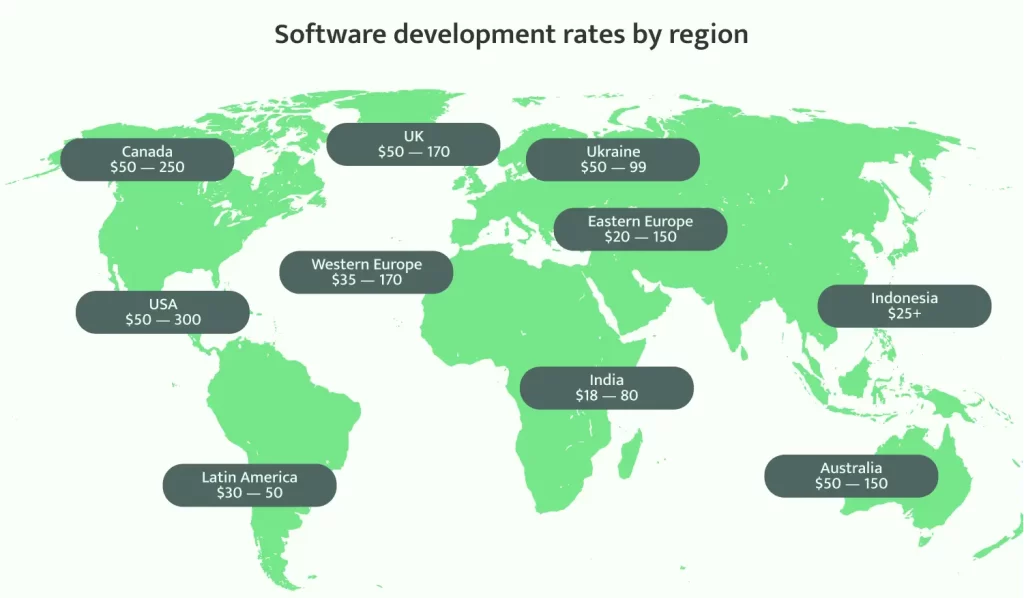How Much Does It Cost to Make a Mobile App?

Alternative-spaces’s clients often ask us to estimate the cost to develop an app so they can start planning or securing funds for the project. That’s because our team has pervasive 20+ years of expertise in software and web development.
Table of contents
- The Cost of Developing Some Popular Mobile Applications
- Factors for Mobile App Development Cost
- Development Cost by Mobile App Type
- Application Cost Depending on Technologies
- Cost of Design in App Development Budget
- App Development Team
- Cost of Web Development by Region
- What are the hidden costs of mobile app development?
- 8 Steps to Estimate Your Project Development Cost
- How Much Does it Cost to Update a Mobile App?
- How to Reduce The Cost of Developing a Mobile Application?
- Getting a Quote
- Final thoughts
- FAQ
This post will explain how app development factors impact the price. There will also be tips about getting a more precise quote or determining a rough estimate on your mobile application.
The Cost of Developing Some Popular Mobile Applications
Mobile applications have become enormously popular, evident by the fact that app stores offer over two million apps for download for both iOS and Android users. Despite the fact that mobile applications may appear simple to use from a user’s perspective, a lot of complex development is often needed to create high-end applications. This comes at a cost, as organizations use their allocated budget and resources to build marketing materials, develop base code and plan out every stage of the application’s lifecycle. Let’s look at some famous mobile applications and their estimated cost for development.
Airbnb
Building an app like Airbnb can be a complex and expensive endeavor. The cost of developing such an app generally depends on the features and functionality you want to include, as well as the platform on which it is being built. Generally speaking, you can expect to pay anywhere between $20,000 and $150,000 for development costs alone.
This range covers everything from basic design elements to advanced features like real-time booking or payment processing options. Additionally, there are other factors that could influence the overall cost of your project including maintenance fees and third-party integrations such as Google Maps or Stripe payments.
Ultimately, the total cost will depend on what type of app experience you are looking for and how much work needs to go into creating it. It is always best to discuss your needs and budget with an experienced app development team before moving forward.
This is how basic feature set for Airbnb-like app look:
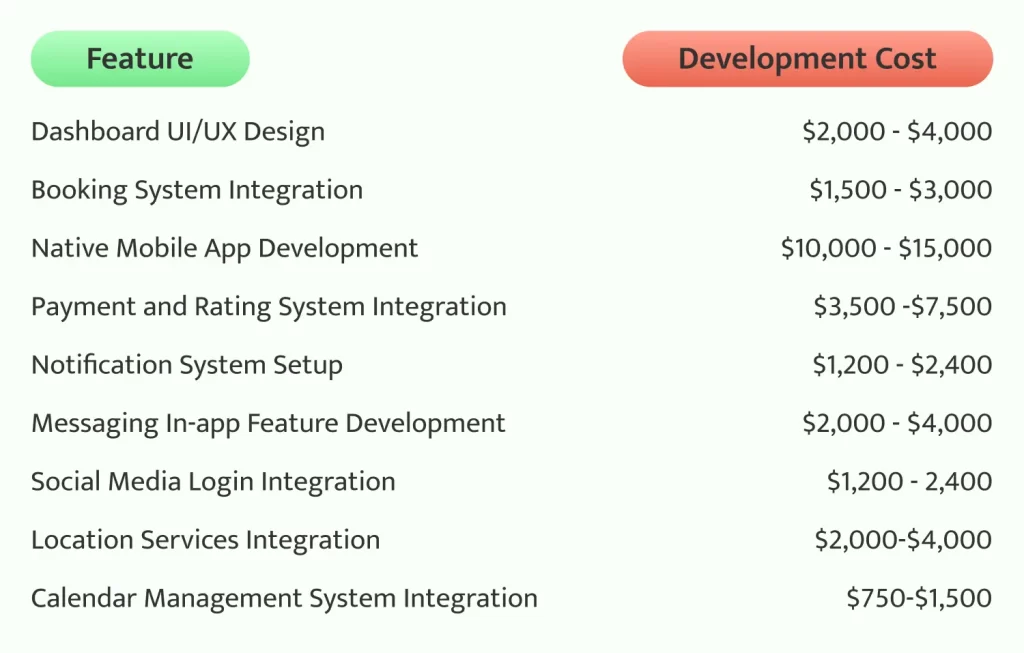
Udemy
Creating an app like Udemy can be a costly proposition, with estimates ranging from $50,000 to over $500,000. It all depends on the complexity of the project and its scope. Many factors can affect the cost of building an e-learning platform or app such as Udemy, including design costs for mobile UX/UI design, development, and more. To give you an idea of what it might cost to build your app like Udemy, let’s look at some key elements that will factor into the overall cost.
Design Costs: Designing an intuitive user experience is essential when creating an app like Udemy. Creating a user interface that is easy to use and visually appealing will require the expertise of UX/UI designers, which can add significantly to the overall cost of your project.
Development Costs: For an app like Udemy to be successful, it needs to have a robust backend with reliable APIs and integrations. You will need to hire a skilled team of developers to ensure that all the features you want are delivered on schedule. This will also add cost to your project.
Testing & QA Costs: Quality assurance testing is crucial in building any product, especially one as complex as Udemy’s. You will need to hire a team of testers and QA engineers to ensure that the platform is functioning correctly before it’s released. This will add to your overall cost as well.
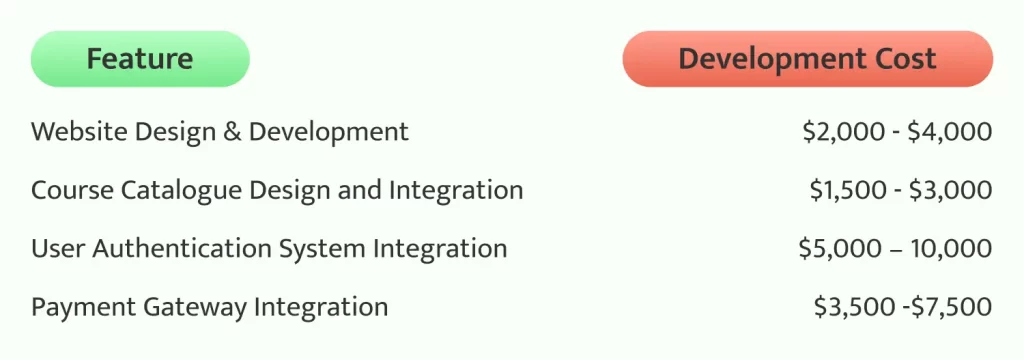
Robinhood
The cost to build an app like Robinhood will vary depending on the complexity of your project, as well as who you hire to do the work. Generally speaking, you can expect to pay anywhere from $50K for a basic version of the app to $250K for a more complex version with additional features and functionality. Of course, this is just a rough estimate; your actual costs could be higher or lower depending on your specific requirements.
Here is the complete list of Robinhood app features:
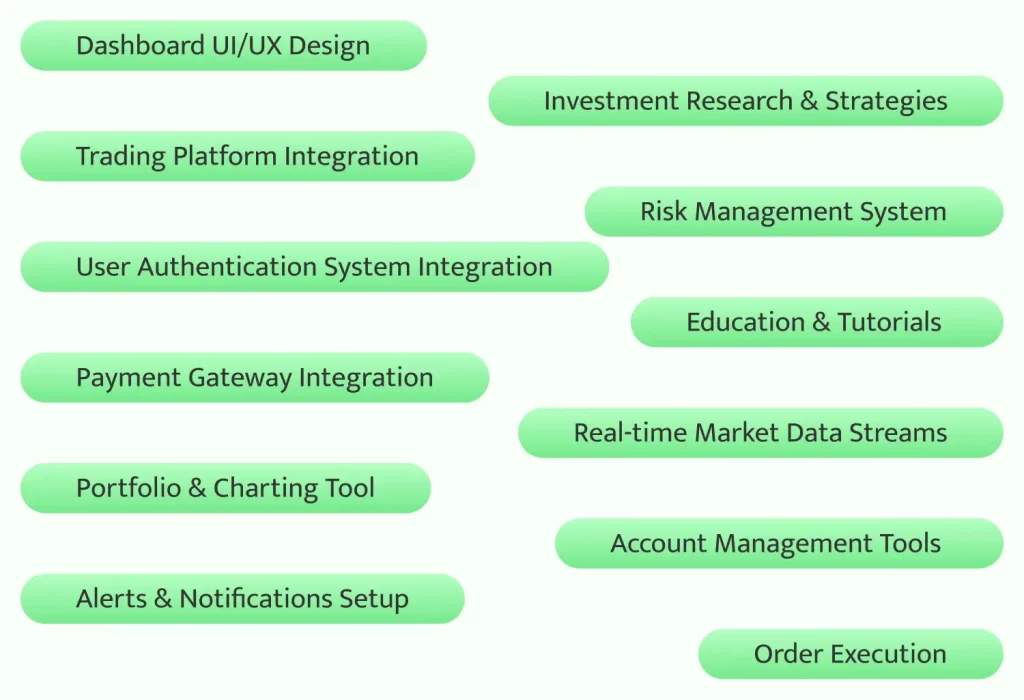
Factors for Mobile App Development Cost
App development cost = (Features X Development time) x Hourly rate
You will be dealing with these variables at each step of the mobile app development process:
- discovery/planning stage
- design
- development
- testing and deployment stage
- startup costs (marketing, support, etc.)
Your decisions and choices at each stage will directly affect the final development cost and timeframe.
Development Cost by Mobile App Type
The App feature set is the primary factor that determines the mobile app development cost. In general, mobile apps can be broken into four major groups, depending on the purpose, complexity, and hence the total work hours required:
1. Simple: Often list- or table-based, an app with 3-4 screens and one primary function. It displays a relatively simple information collection and doesn’t store any data. The cost of such apps is the lowest, often between $1,000 and $10,000.
2. Database-dependent / dynamic / API apps: A more complex app that stores data on the user’s device or a remote server. It may require users to register, allow them to find, input, and display data, sync data between multiple devices, connect to remote online web services, etc. The use of Application Programming Interfaces (APIs) that vary in complexity affects the end cost. According to Appster’s data, such apps can range between $10K-$50K.
3. Multi-functional / enterprise or brand apps: Several core features and custom user interface assist with business activity. Such apps usually require the use of extensive databases, advanced UI, and commerce integration. The cost can range between $20,000 to $500,000.
4. Games: Games can cost anywhere from $5,000 (simplest ones) to $250,000+, especially high-quality complex games with 3D environments or advanced physics engines.
Delivery time may depend on your development team’s velocity, but a simple app may take from two weeks to three months to complete, a dynamic app – some 3-6 months, and a sophisticated multi-feature app may take 3-9 months to create. If time is critical, the team may need to engage extra staff or pay overtime. This will result in higher overall costs.
The selection of features directly impacts the future product’s user-friendliness, monetization, viral potential, marketing opportunities, etc. Important things to consider include, but are not limited to:
- login via Facebook, Twitter, Google, or email (approx from 8 to 16 hours)
- ability to post on a user’s social media (from 8 to 16 hours)
- chat / messaging (from 40 to 120 hours)
- user profiles (from 24 to 40 hours)
- search functionality (from 8 to 80 hours)
- in-app purchases (40+ hours)
- push notifications (40+ hours)
Some of these require only several hours of development, but each will compound the total cost. Consider your long-term goals. If the product is the backbone of your startup, more features and higher cost are reasonable. But if you are only developing a prototype, you may launch with a core feature stack. Eventually, you’d build on with micro updates allowing you to hear user feedback and more effectively adjust the roadmap as the product grows and evolves.

A few other factors driving the cost of mobile application development are:
- The app’s uniqueness translates directly to the developers’ rates. If it requires a high degree of specialty or rare skill sets, the ‘hourly rate’ in the equation will be greater.
- The cost of customized UI design would be higher too. This requires in-depth research, and the implementation is more time-consuming than a standard design.
- Choose the platform where your target consumers really are, but accessibility on both iOS and Android seems the wisest.
- The number of screens matters as well. The more of them the app includes, the more design and development work it requires.
- Many intricate screens will take longer both to design and to develop and thus will cost more.
- Each integration with third-party services, APIs, libraries, or framework adds extra time and cost.
- The integration of GPS navigation, NFC, Bluetooth, or onboard sensors will also alter the overall cost of the app.
- Supporting offline app usage will also increase the cost.
Application Cost Depending on Technologies
An app can be used on various devices. The price of the app development will depend on which mobile app development technologies you choose:
- Native mobile apps are written in the same programming languages as the platforms for which they are designed. Such apps are faster, more reliable, and provide the best user experience. Two separate apps will certainly cost more than one. At the same time, each platform’s development environment provides for building a standardized convention, and mobile app development using the standard convention is generally considered to be more cost-effective.
- Cross-platform apps run on both the iOS and Android mobile platforms. They are built using a combination of web and native technologies. The code repeatability makes the development more cost-effective. However, they can be problematic to design due to the platforms’ different conventions.
- A progressive web app is a mobile-optimized website with most of the features and the feel of a native app. Users can access it through the browser and simply add it to the home screen. They provide an acceptable user experience and are affordable to develop.
- A hybrid app can operate on multiple platforms and function like a native app. The developer builds the product once using, for example, HTML5, CSS, and JavaScript and then use PhoneGap to prepare it for all platforms. This approach can significantly reduce the cost of building an app but will have more restrictions related to this platform.
- Third-party app integrations: Integrating services from third-party vendors is often necessary to provide certain features that would be expensive or difficult to achieve with in-house resources. Choosing the right third-party provider is critical, as it can affect the cost and quality of the overall application. Additionally, some services may require maintaining an API or implementing a specific codebase to successfully maintain a connection. It is important to carefully consider these factors before deciding which vendor and integration method work best for your application. Furthermore, be aware that additional costs may be associated with third-party integrations, such as fees, hosting costs, and user licensing.
Currently, it’s mainly about the two leading mobile operating systems – iOS and Android. Android users dominate the mobile web traffic. The cost per install is significantly lower for an Android app than for iOS, which means a wider market for a business.
Choose the platform where your target consumers really are, but accessibility on both iOS and Android seems the wisest. If you decide to launch on both mobile platforms simultaneously, there will also generally be some crossover that ultimately lowers the total cost. More often than not, there will be a common back-end architecture. Moreover, since the team had detected and resolved some issues when building the app for one platform, they will be able to develop the subsequent one faster.
In any case, you will also have to decide what specific devices your mobile app will support. For example, it may be accessible only on smartphones of exact models or on multiple versions of tablets as well. Developing custom interfaces to support all screen resolutions can be time-consuming and costly for Android. Supporting all of the OS versions of all devices will be expensive, so it’s better to select only the most popular ones.
If the developers are required to pay a license fee for technologies, it may significantly increase an overall mobile app development cost. It will depend on the annual fees and the number of devices.
Cost of Design in App Development Budget
While the average surveyed cost of an app’s design is about $10,000, it’s as important as technology. There are several aspects to it:
- The visual design gives your app a distinctive look and feel. Great design often comes at a cost, so prioritize the components if your budget is limited. If your target audience is very design-sensitive, it’s reasonable to divert some money from other departments toward high-end UI design. But if not, there’s no need to overpay for looks alone.
- UX design pertains to the layout of the features and how users interact with the app. The UX designer studies user behaviors and designs user experiences to deliver specific results. Such expertise and skills may be your most significant expense for the app’s design, but it’s money well spent.
- The icon, logo, and branding cost less, but shouldn’t be neglected either. An icon’s price alone may range from $300 to $1,500, but you’ll definitely see the difference between a ‘cheaper’ and a costlier version – and so will the target audience.
- Invest in good, compelling copy for the app. The voice and tone must ideally match your brand.
If you want the design to give you a competitive advantage, hire a proven design team with an extensive portfolio. But remember that outside designers will have to collaborate with the app development team, which may slow down the work. Often, it proves more convenient and cost-effective to have an app development company handle both the design and development of your app. (Alternative-spaces has a design department that is well-practiced at designing for mobile too.) From branding to UX design, and then from coding to deployment – you can have it all done under the same roof.
App Development Team
The talent and experience of the development team affect the cost of mobile application development as much as its envisioned functionality. When recruiting the team, your choices can either save or add a substantial cost to the project. Cheaper isn’t necessarily better and can often be quite the opposite.
Unless you are blessed with a lean in-house team or someone who can play multiple roles, you’ll have to look for experts at each step of the software development process. Developers will be programming the app screens in Objective-C/Swift for iOS or Java/Kotlin for Android. Another developer will work on the server-side application and APIs. Quality assurance should participate from the onset. Installing the application, creating a reliable server environment, and tackling database redundancy, backup, security, performance, and scalability of the app requires an experienced specialist commonly referred to as DevOps.
Depending on the way you are going to create the app, you can choose one of the four primary models of engaging talent (in the price-decreasing order):
- Technical co-founder
If you’re an established business person, you may recruit technical co-founders and pay them in equity.
- Domestic app development company
App development agencies provide a complete team necessary for building and launching a product. It’s the surest way to make a quality app, from the planning stage to post-launch marketing, but also the most expensive. Such agencies charge $200-$300/hour for their services.
The larger the app agency (with its track record, reputation, reviews, and awards), the higher the price usually is. Big agencies offer a broader range of services, larger teams, heaps of experience, mature development procedures, and a big brand guarantee of quality and timely delivery. If your app is very sophisticated, this may be the only development option for you.
Small agencies (3-10 members) typically focus on a specific class of apps. While an attractive middle ground on quality and consistency, small domestic agencies also provide significant cost savings as compared to large agencies.
- Freelancers
Hiring freelancers may be the cheapest option but may turn out to be the most expensive. If the freelancer happens to be slow, incompetent, or irresponsible, your project will drag on indefinitely. Hiring a handful of freelancers only increases the risks: each of them can potentially cause problems and delays. On top of that, many freelance platforms are plagued by the ‘problem of middle-man freelancers.’ In the worst scenario, you’ll be throwing money down the drain.
However, if you manage to recruit a group of good freelancers, you can get a quality app made at a lower cost. Good freelancers may provide the quality level of an app development company, but their prices differ drastically depending on the freelancers’ locations. India boasts about the lowest rates ($10-75+ per hour) while the US, Canada, and the UK have the highest ($50-$250 per hour).
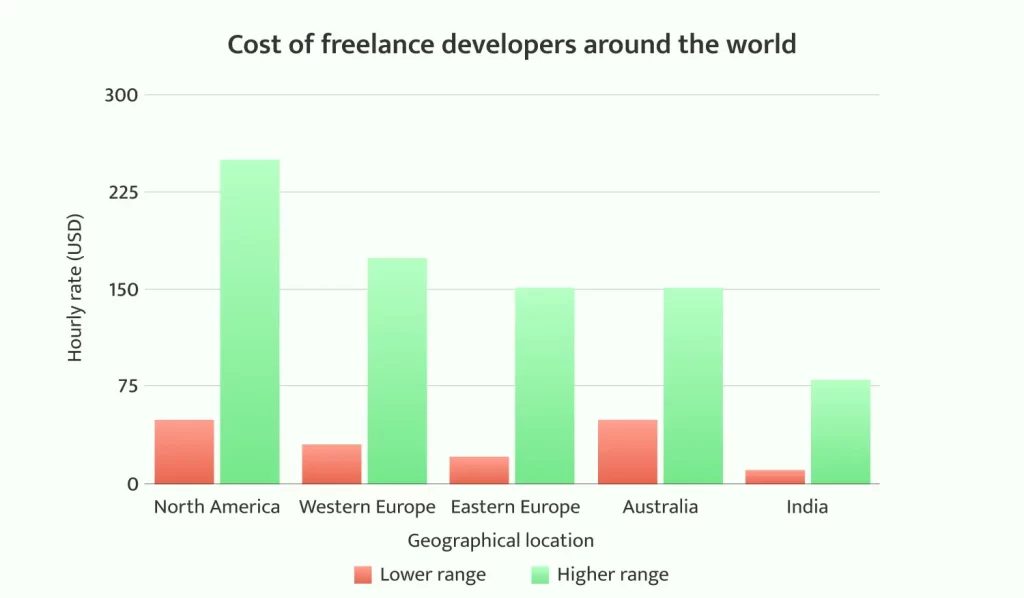
- Outsourcing
This is another good option for software development at a reasonable price. Outsourcing companies combine the benefits of app development agencies and international freelancers. Most will offer a full-fledged team of designers, developers, and project managers for an entire project – all at an Indian or East European price. For example, the average hourly rate is typically three times lower in Ukraine than in the US, with the same quality and expertise. Collaboration across oceans has become easier; JIRA, Slack, and GitHub are used for organizing the process and daily communication with customers.
However, the service price shouldn’t be the ultimate deciding factor for hiring an offshore development team. Remember that it may be a years-long relationship if they should continue maintaining your mobile app. Before making the decision, speak with several teams, search each one’s portfolio for recent examples that are most relevant to your project, ask for references, and read clients’ feedback and other information you may find online.
Cost of Web Development by Region
The cost of web development can vary greatly depending on the region. Generally speaking, countries in North America and Western Europe will be more expensive than those in South America, India, and Southeast Asia. Thus, let’s check software development rates in different parts of the world.
What are the hidden costs of mobile app development?
On top of the components disclosed above, there are hidden costs that weigh on the overall cost of a mobile app.
You’ll need to pay App Store and Google Play fees, admin, servers and backend support, customer support, legal, and further development costs. According to Clutch, infrastructure-related activities like the initial setup and basic controls, data storage, third-party integration, access to enterprise data, data encryption, and scalability are massive cost drivers.
Maintenance expense is not included in the initial app development cost breakdown, but on average, 15-20% of the original development costs are spent annually on technical support.
Some developers, though, may integrate short-term app maintenance into their build price. Alternative-spaces does offer free maintenance for three months.
Your intellectual property should be protected. Get a patent to protect your invention and ideas. If your app’s name sticks, register it as a trademark. Protect the text, visuals, and multimedia of your mobile app through copyright. It entails extra expenses, but it’s important.
Sales and marketing can be another massive expense. Without paid marketing, it’s almost impossible to get noticed on app stores. Not having the budget to market the app can be fatal for the entire project.
8 Steps to Estimate Your Project Development Cost

1. Gather information about the project. This includes details about the scope, timeline, and resources needed.
2. Develop a budget outline that lays out all of the potential costs associated with the project, including labor and services.
3. Estimate the costs of each item listed in the budget outline by working with vendors or subcontractors to get quotes on materials, labor, and services.
4. Leverage past projects or historical data to assess potential risks and identify any additional costs that may arise.
5. Analyze the results of the cost estimate to ensure accuracy and identify areas where savings can be made or alternate solutions can be used to reduce costs.
6. Present the cost estimate in an organized format. This should include a summary of the total projected costs, as well as details about individual components.
7. Review the cost estimate with stakeholders to ensure accuracy and address any questions or concerns they may have.
8. Monitor progress throughout the project and make adjustments as needed to ensure that costs stay on target.
9. Provide regular updates to stakeholders to ensure that they are aware of any changes or issues related to the cost estimate.
10. Finalize the cost estimate when the project is complete and present a final report to all stakeholders.
How Much Does it Cost to Update a Mobile App?
It’s important to keep your app up-to-date, especially if you want to take advantage of new features that come with new versions of iOS and Android. According to Clutch’s survey, you should plan $10,000 – $14,000 for app maintenance, which is still pretty high.

However, at Alternative-spaces, we believe that 15% of your app development budget is enough for maintaining an app on a yearly basis.
This will allow you to take advantage of updated or new features and keep your app running smoothly. So if you’re looking to update your app, be sure to factor in these costs!
How to Reduce The Cost of Developing a Mobile Application?
There are numerous ways you can save money on your mobile app development budget. You need to find a balance between having a comprehensive app with great potential and an affordable budget. Here are some tips on how to reduce the cost of developing your app:
1. Start small with an MVP. There are a lot of factors to consider when building an MVP app. Start by focusing on the key features your users need and want. From there, you can plan the rest of your MVP features. Remember, getting feedback from your target audience is essential to make sure your MVP is successful.
2. If you’re not planning on making any major changes or additions to your app in the near future, consider using a pre-built template or theme. This can save you a lot of time and money in the development process.
3. Use open-source tools and resources whenever possible. There are many great options available that can help you keep your costs down.
4. Consider cross-platform development. There are many cross-platform development frameworks available, such as Flutter and React Native. These frameworks allow you to develop iOS and Android versions of your app simultaneously, saving you time and money. However, if your app depends on lots of custom animations, we recommend developing the iOS version in Swift and the Android version in Java or Kotlin. This will give you the best performance and compatibility.
5. Be selective about the features you include in your app. Keep your focus on the core functionality and only include features that are absolutely necessary. This will help you keep your development costs down.
By following these tips, you can significantly reduce the cost of developing your mobile app without sacrificing quality or functionality.
Getting a Quote
Like other software development companies, Alternative-spaces is contacted daily by people with great ideas asking for quotes for their apps and websites. However, as interested as we are, it’s impossible to estimate the price right off the bat. For this reason, most companies would request the future product’s specifications first.
A mobile app development specification document is known as a requirements document or product specification. The specification not only provides a foundation for a successful product but also serves as a basis for the app development cost estimate.
Here you can find some tips on crafting a decent requirements document, which is mostly about conveying your vision to those who will work on the product. In a nutshell:
- the product requirements document should have all critical areas covered and eliminate any ambiguity
- it should clearly define the scope of the work and prioritize the app’s features
- describe the product in the same sequence as users would be exploring it, and don’t forget about such standard features and screens as the privacy policy
- references to existing apps when describing your product, e.g., for an analogy, are welcome
- if applicable, indicate the specific deadline and provide a short timeline for important milestones to meet
- indicate whether you want to build a native or a hybrid app and try to define the supported device range
- if the app draws on an external database, explain whether that database needs building or already exists, if there’s a web server and documentation for an API, etc.
- if you did some market research, include your discoveries
- if you have brand guidelines, like a style guide, provide them too
- if possible, visualize the app requirements in sketches, create wireframes of the screens of the application to accompany your textual description, and draw whole screen maps
The last is one of the most efficient methods. Around 70% of mobile app development time is spent on interface implementation, so having all of the screens would give the design and development teams a better sense of the scope of the work.
Present your project to at least five different developers or agencies. At Alternative-spaces, we’d also ask about your background. Can you tell us about your business or organization? Is it your first app? Do you have a web solution already? What are your long-term goals for the product? What problems have you encountered? All this information helps software developers assess your business concept and propose relevant solutions. If a customer wants a non-disclosure agreement to be signed, we do this on a regular basis. We respect our customers’ confidentiality.
After analyzing the requirements document, if available, we typically do the first rough assessment of the project based on the approximate number of hours required. If the customer has approved it, we’ll discuss the requirements in depth and further learn their needs, hesitations, and preferences.
Most times customers don’t like to disclose their budget limitations, but if they exist, it’s better to at least mention them during a call. Based on the available budget and additional product insights provided, the project manager will be able to estimate what’s feasible for that money and prioritize features. There is always an opportunity to suggest better, more realistic, or cost-effective options. We’ll be sure to lay them out with the reasoning in plain English.
For this table, we took the minimum price per 1 hour – $40.
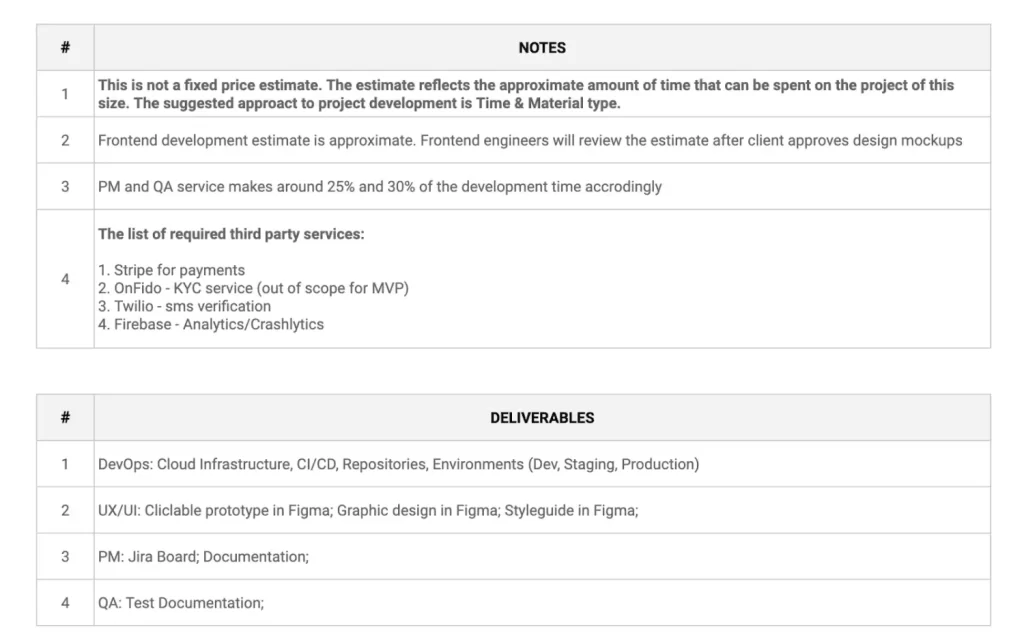
After we identified requirements for each stage of the design and development, we present a more detailed and accurate app development cost breakdown. This gives the client a ballpark range to plan for, but we always warn them it’s not carved in stone: any changes and additions that the client may require eventually will affect the total final cost for sure.
Pricing falls into two different structures:
1. Fixed price – a set total price and timeline works well for smaller projects (within 170 person/hours of work) with a clearly defined scope. To reserve padding for complexity, which is hard to predict, we add some 25% for ‘risks’ to the actual calculated amount.
2. Time and materials/price range is determined by the time and materials needed for a project and typically is an hourly rate. This pricing structure applies to larger projects that have unpredictable, moving parts and a more ambiguous scope.
If you are not yet ready to contact an app development company, there is an alternative cost estimation opportunity. You can use one of the online development cost calculators, such as:
- Andreas Ley’s Cost Calculator
- BuildFire’s Mobile App Building Calculator
- Estimatemyapp
- How Much to Make an App
- Imason Calculator
- Newsignature
- Otreva Calculator
It goes without saying that these instruments give only a rough app development cost estimate. Although they are based on the same development steps and factors that go into creating a quote for a mobile app project, every app’s unique requirements will carry a corresponding cost. You won’t know precisely how much each feature may cost until you’ve solicited quotes from multiple qualified developers.
Moreover, the calculators won’t account for a developer’s specific method for charging. Still, a development cost calculator can give you a good ballpark range of what to expect before asking for quotes.
Final thoughts
The cost of mobile application development may range from $10,000 to $500,000. Any project’s cost correlates with the time required and the quality that should be achieved. In the case of mobile apps, this means primarily whether the app is hybrid or native, the number and complexity of features, and the choice of the development team.
An app development cost breakdown includes, but may not be limited to:
- number of screens
- type and business model
- platform / technology / devices
- functionality / technical specifications
- custom features or unique functions
- design requirements
- developers’ rates
- person-hours required for the build
- amount of testing and refinement required
- need for a user-friendly back-end app management platform
- the project’s time frame
The business model driving your decisions, the platform, the required functionality, and design can hardly be manipulated. However, engaging foreign developers and any trade-offs you’re willing to make can help reduce the mobile app development cost significantly.
Creating a successful product requires many considerations, such as the concept, monetization method, design, user-friendliness, etc., and different skills at all steps. Based in Eastern Europe, Alternative-spaces provides full-cycle web and mobile app development, including analysis, UI/UX design, development, testing, deployment, and further updates. We’ll be glad to review your ideas and make recommendations for a great final result.
Contact us if you’re ready to start a new project!
FAQ
1) What is the average cost of developing a mobile app?
This is a difficult question to answer due to the many variables that can impact development price. Generally speaking, the cost of developing a simple app with basic functionality can range from $10,000 to $50,000. However, more complex apps with advanced features and functionality can cost well over $100,000.
2) What factors influence the cost of app development?
The cost of app development is influenced by a number of factors, including:
-The complexity and scope of the project
-The platform (Android or iOS)
-The type of app (game, business, social networking, etc.)
-The level of customization and functionality required
-The number of users expected
-The amount of testing and bug fixing required
-The level of support and maintenance needed after launch
3) How can I reduce the cost of developing my app?
There are a few ways to reduce the cost of app development, including:
-Choosing a simpler app with fewer features
-Developing for a single platform instead of multiple platforms
-Using existing templates or frameworks rather than custom development
-Minimizing the number of user permissions required
-Optimizing the code to reduce loading time and bandwidth requirements
-Outsourcing certain aspects of the project to third-party developers or agencies
4) What are the most expensive components of app development?
The most expensive components of app development are typical:
-Design and user interface design
-Development and coding
-Testing and bug fixing
-Marketing and promotion
5) How can I get an estimate for developing my app?
If you’re looking for a ballpark estimate for developing your app, you can use services like App Cost Calculator or Mobile App Development Pricing. These services provide estimates based on the complexity and features of the app, as well as the estimated time required for the development. However, it’s important to note that these estimates should only be used as a general guide and that the final cost may vary depending on the specific needs and requirements of your project.
6) What are some common mistakes people make when estimating the cost of app development?
One of the most common mistakes people make when estimating the cost of app development is not taking into account all of the variables that can impact the price. For example, a simple app with basic functionality may seem like it would be cheap to develop, but if the design requires a lot of customization or the code needs to be heavily optimized, the final cost could be much higher. Another mistake is underestimating the amount of time and effort that goes into developing an app, which can result in cost overruns and missed deadlines. Finally, many people forget to budget for post-launch costs such as marketing, support, and maintenance.
Content created by our partner, Onix-systems.
 Home
Home